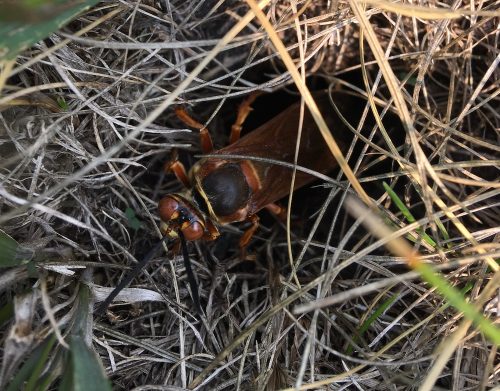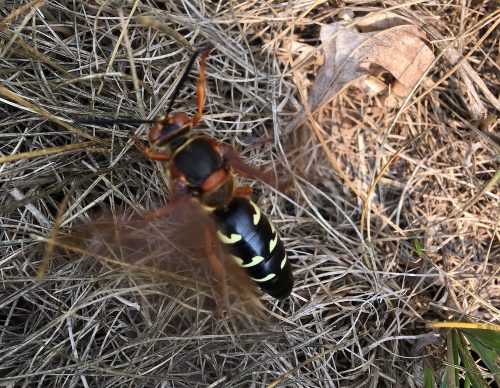Cicada-killers!
Yes, please, make yourself right at home. Do you have more family you can invite over? August is coming soon, and it’ll be time for a feast. Please do. Kill all those wretched noisy shrill shrieking beasts and dismember their bodies and chew on their guts, thank you very much.




Some sort of solitary burrowing wasp?
They are a solitary, ground nesting wasp that rarely attacks humans.
I’m quite surprised. July in Central Illinois is usually a nonstop drone of cicadas on a normal year. I was expecting it to be 10X worse this year but I’ve barely heard any.
Pah ,you wouldn’t be so eager if it was a spider hunting wasp.
I like cicadas .they sound like summer to me
Speaking of…
These have been out for a while now here in AZ.
https://en.wikipedia.org/wiki/Tarantula_hawk
Love these wasps!
Wrong! They NEVER attack humans. A female might sting in self-defense if you grab her. That would not be an “attack”. Even if you hang around her nest, she doesn’t want anything to do with you.
And males don’t have the parts to sting, just like all stinging ants, wasps or bees.
Fun to just observe their behaviors. The males (presumably) visit flowers along with the other pollinators.
The females dig out easy-to-see nests in sandy soils in sunny areas, leaving a distinct trench of excavated sand leading out of the burrow. The trench is about as wide as your thumb (mine, anyway), and the pile of excavated sand can be a few handsfull. The females return to the burrow with the cicada victim, landing with an audible thud when they hit the ground. It must be an extraordinary effort because the cicada is about as big as the Cicada Killer herself. She’ll load each tunnel with a few cicadas to feed her babies, then seal it up and go make another nest.
Very handsome colors. Do an image search.
They are bigger and slower fliers than other wasps and thus easier to observe. They are a bit curious too, they will hover around you to check you out, and invariably move on shortly.
Did I say that I love these guys?
First time I encountered one of those in the yard, I about lost it. Then I learned about them and we became friendly neighboors.
I used to be fairly terrified of these huge wasps when younger. But in fact they are very docile toward people. I’ve gotten right up on them to watch closely. Within inches. And at most all they did was roar away. It’s a safe thrill.
@7 Ants don’t sting ,they bite you then squirt Formic acid where they have bitten you.
Or so i read somewhere ,i may be mistaken ,i usually am .
That moment when the iridescent thing flys by your ear and, that’s not a humming bird bit it’s about as big.
@10 davidc1:
Some ants have workers that do sting. Fire ants, for example. Their fire is their sting. They clamp on with their mouth and poke you with their stinger, which is just a modified ovipositer (egg laying tube, essentially).
A name like “Crabronidae” shouts “don’t mess with me!”
I like the idea of burrowing predators that can fly, but they need an edge if they are to take on something bigger than cicadas. Telepathic group intelligence, like the big arthropod critters Ender was fighting?
The ability to morph into big transformers?
When I was growing up in central Indiana, we had one under our patio one summer. I enjoyed watching it until our cat decided it was something to attack.
I’m not sure how the cat avoided being stung, but she disabled it to the point where it couldn’t fly properly, and at that point I captured it in a jar, where it died. It was fun to pull out and show friends at school, just because the size of these things is so impressive.
I haven’t seen any lately, but I’ve had some sort of sand or digger wasps in my yard before. I think they are cool as hell.
Preferable to the colonial wasps that have nested near my front door. In those rare cases I went with the death spray. Got stung right on the ear lobe once before and fixed their wagon when I got home. They drew first blood not me.
I really need to see a pic of one of these wasps next to something common, for scale. How do they compare to, say, your average skyscraper?
@12 That’s what i was truing to say ,thanks ,
@17, The images in the OP seem to have been taken from the Andromeda Galaxy. Whilst perhaps not immediately, obvious, the strands and wisps (which look slightly like dried grass and leaves) is intervening cosmic dust and fleeing refugees. Whilst this doesn’t precisely resolve the scale issue, it does suggest the visible part of the wasps are slightly smaller than the Milky Way galaxy, but probably larger than the Solar System. The actual size, including the non-visible parts, is harder to determine, but is perhaps a significant portion of the “missing” gravitational source, Dark Matter.
Unfortunately, their diet is rather limited, and they do not, e.g., eat Republicans or other nazis.
Blf @ 19
Maybe we can spray the Republicans with pheromones that makes them seem tasty?
I was once stung by something that sure looked like a cicada killer, and man did it HURT! Felt like Rocky Marciano had punched me in the arm.